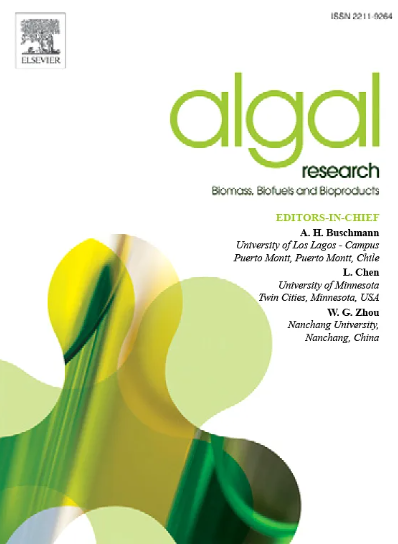Multispectral imaging techniques for evaluating physicochemical-, antioxidant, and sensory properties of Alaria esculenta and Saccharina latissima
IF 4.6
2区 生物学
Q1 BIOTECHNOLOGY & APPLIED MICROBIOLOGY
Algal Research-Biomass Biofuels and Bioproducts
Pub Date : 2025-03-21
DOI:10.1016/j.algal.2025.104009
引用次数: 0
Abstract
With the increased seaweed production worldwide, there is a need to focus on improved production practices to produce high-quality seaweed biomass, especially if the biomass is intended for high-quality products and human consumption. Multispectral imaging (MSI) is a novel technique used as a quality control tool within the food industry due to its rapid, real-time measurements. Therefore, the study aimed to assess the possibilities of using MSI as a quality control tool within seaweed cultivation to predict the physicochemical (including proximate composition, trace minerals, pH, and color), microbiological (total viable counts (TVC)), sensory, and antioxidant properties of A. esculenta and S. latissima throughout diverse processing and handling. The results showed differences in spectra between species, and species classification got 100 % accuracy when using a Support Vector Machine (SVM) with the spectral data. Furthermore, results indicated that the partial least square regression (PLSR) models developed with cross-validation of the MSI data effectively predicted multiple quality parameters, including pH ( = 0.94, RMSECV = 0.278), carbohydrate content ( = 0.89, RMSECV = 0.76), protein content ( = 0.94, RMSECV = 0.12), ash content ( = 0.80, RMSECV = 0.51), and phenolic content ( = 0.992, RMSECV = 0.24). In addition, the results showed possibilities of using the technology to assess several sensory properties. In conclusion, the results show the potential of using the MSI technology as an effective quality control tool within the seaweed industry to simultaneously evaluate multiple physicochemical properties of brown seaweed biomass.
求助全文
约1分钟内获得全文
求助全文
来源期刊

Algal Research-Biomass Biofuels and Bioproducts
BIOTECHNOLOGY & APPLIED MICROBIOLOGY-
CiteScore
9.40
自引率
7.80%
发文量
332
期刊介绍:
Algal Research is an international phycology journal covering all areas of emerging technologies in algae biology, biomass production, cultivation, harvesting, extraction, bioproducts, biorefinery, engineering, and econometrics. Algae is defined to include cyanobacteria, microalgae, and protists and symbionts of interest in biotechnology. The journal publishes original research and reviews for the following scope: algal biology, including but not exclusive to: phylogeny, biodiversity, molecular traits, metabolic regulation, and genetic engineering, algal cultivation, e.g. phototrophic systems, heterotrophic systems, and mixotrophic systems, algal harvesting and extraction systems, biotechnology to convert algal biomass and components into biofuels and bioproducts, e.g., nutraceuticals, pharmaceuticals, animal feed, plastics, etc. algal products and their economic assessment
 求助内容:
求助内容: 应助结果提醒方式:
应助结果提醒方式:


